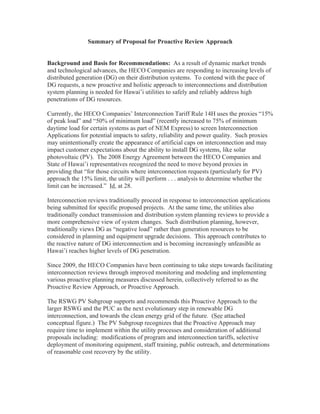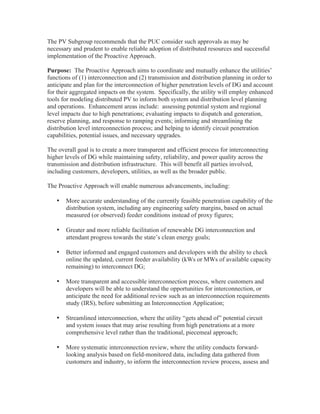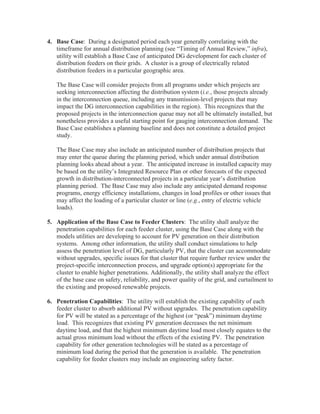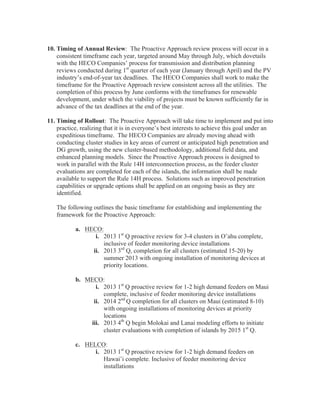The document proposes a Proactive Review Approach for reviewing and approving distributed generation interconnection requests in Hawaii. This approach aims to coordinate interconnection and distribution planning to anticipate higher levels of distributed generation. Key aspects include using enhanced modeling informed by monitoring data, establishing an interconnection queue, setting an annual baseline of anticipated projects, and identifying any necessary upgrades to facilitate higher penetrations of distributed generation while maintaining reliability. The goal is to create a more transparent and efficient process for interconnecting renewable energy.




![Distinct from the current proxy levels in interconnection procedures (e.g., 15% of
peak load and 50% of minimum load), the penetration capability will establish, based
on actual analysis, the feeder availability. The feeder availability is the maximum
kW or MW value of DG, particularly PV, that can be interconnected to a feeder with
the existing equipment on that feeder, including protection and control equipment.
In order for this system of measuring penetration capabilities in terms of percentages
of minimum load to work, the utilities must establish and maintain the ability to
measure minimum loads on their distribution systems. The HECO Companies have
largely, but not completely, installed such capability. To this end, the utility shall
continue to install the necessary equipment to measure load profiles on feeders with
priority focus on existing high penetration feeders and moving to feeders with DG at
or above a threshold of 10% of peak feeder load.
7. Informing of Upgrades: Where application of the Base Case results in an amount of
generation that exceeds the penetration capability of a feeder cluster without
upgrades, the Proactive Approach may be used to help evaluate options to upgrade
the distribution infrastructure in order to accommodate the Base Case amount of
growth of projected DG. Note: IRS studies may still be necessary for project specific
needs, as determined by the utility. If upgrades are needed, the utility shall determine
the best way to implement such upgrades and allocate the costs, as allowed by law
and tariff. In any event, the utility should inform the customers and developers in the
Interconnection Queue for the Base Case of its determination of any necessary
upgrades and provide appropriate opportunities to proceed with interconnections
through the interconnection process.
[There are a number of open issues yet to be resolved in this proposal. These issues
include clarification of how costs will be allocated to the new generators that seek
interconnection and the tariff changes that may be required to implement the
approach.]
8. Online Information: The utility shall provide appropriate online information where
customers and developers can input addresses and view their interconnection status,
feeder penetration range and known upgrades using online utility DG tracking tools
such as the location value maps (LVM). The goal is to provide customers and
developers with a publicly accessible and transparent system of understanding present
and potential penetration capabilities and minimize misinterpretation of any perceived
or arbitrary feeder caps.
9. Narrowing of Issues: In addition to the penetration capabilities and upgrades above,
the Proactive Approach will help identify any issues requiring further review in the
project-specific interconnection process under Rule 14H. This will facilitate the Rule
14H process by narrowing the scope of interconnection review to an already
previewed set of issues. This preview under the Proactive Approach may inform each
stage of the Rule 14H interconnection process, including Initial Technical Review,
Supplemental Review, and the Interconnection Requirements Study.](https://image.slidesharecdn.com/recommendationreproactiveapproach-130131152553-phpapp02/85/Recommendation-re-proactive-approach-5-320.jpg)

